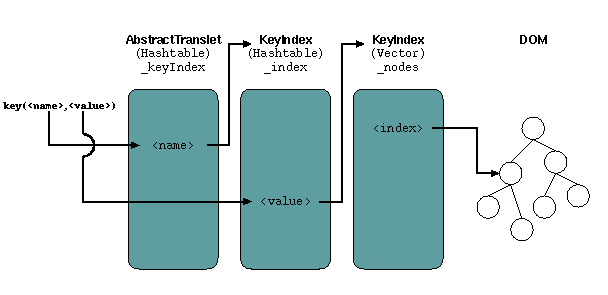AbstractTranslet has a global hashtable that holds an index for each named
key in the stylesheet (hashing on the "name" attribute of xsl:key).
AbstractTranslet has a couple of public methods for inserting and retrieving
data from this hashtable:
 |  |  |
 |
public void buildKeyIndex(String name, int nodeID, String value);
public KeyIndex KeyIndex getKeyIndex(String name);
|  |
 |  |  |
The Key class compiles code that traverses the input DOM and extracts
nodes that match some given parameters (the "match" attribute of the
<xsl:key> element). A new element is inserted into the named
key's index. The nodes' DOM index and the value translated from the
"use" attribute of the <xsl:key> element are stored
in the new entry in the index.
The index itself is implemented in the KeyIndex class.
The index has an hashtable with all the values from the matching nodes (the
part of the node used to generate this value is the one specified in the
"use" attribute). For every matching value there is a Vector
holding a list of all node indexes for which this value gives a match:

Figure 1: Indexing tables
The KeyIndex class implements the NodeIterator
interface, so that it can be returned directly by the implementation of the
key() function. This is how the index generated by
<xsl:key> and the node-set returned by the key() and
KeyPattern are tied together. You can see how this is done in the
translate() method of the KeyCall class.
The key() function can be called in two ways:
 |  |  |
 |
key('key-name','value')
key('key-name','node-set')
|  |
 |  |  |
The first parameter is always the name of the key. We use this value to
lookup our index from the _keyIndexes hashtable in AbstractTranslet:
 |  |  |
 |
il.append(classGen.aloadThis());
_name.translate(classGen, methodGen);
il.append(new INVOKEVIRTUAL(getKeyIndex));
|  |
 |  |  |
This compiles into a call to
AbstractTranslet.getKeyIndex(String name), and it leaves a
KeyIndex object on the stack. What we then need to do it to
initialise the KeyIndex to give us nodes with the requested value.
This is done by leaving the KeyIndex object on the stack and pushing
the "value" parameter to key(), before calling
lookup() on the index:
 |  |  |
 |
il.append(DUP); // duplicate the KeyIndex obejct before return
_value.translate(classGen, methodGen);
il.append(new INVOKEVIRTUAL(lookup));
|  |
 |  |  |
This compiles into a call to KeyIndex.lookup(String value). This
will initialise the KeyIndex object to return nodes that match the
given value, so the KeyIndex object can be left on the stack when
we return. This because the KeyIndex object implements the
NodeIterator interface.
This matter is a bit more complex when the second parameter of
key() is a node-set. In this case we need to traverse the nodes in
the set and do a lookup for each node in the set. What I do is this:
-
construct a
KeyIndex object that will hold the return node-set
-
find the named
KeyIndex object from the hashtable in
AbstractTranslet
-
get an iterator for the node-set and do the folowing loop:
- get string value for current node
- do lookup in KeyIndex object for the named index
- merge the resulting node-set into the return node-set
-
leave the return node-set on stack when done
The only work that remains is to update the merge() method of
the KeyIndex class so that it eliminates duplicate nodes in the
resulting node-set.

